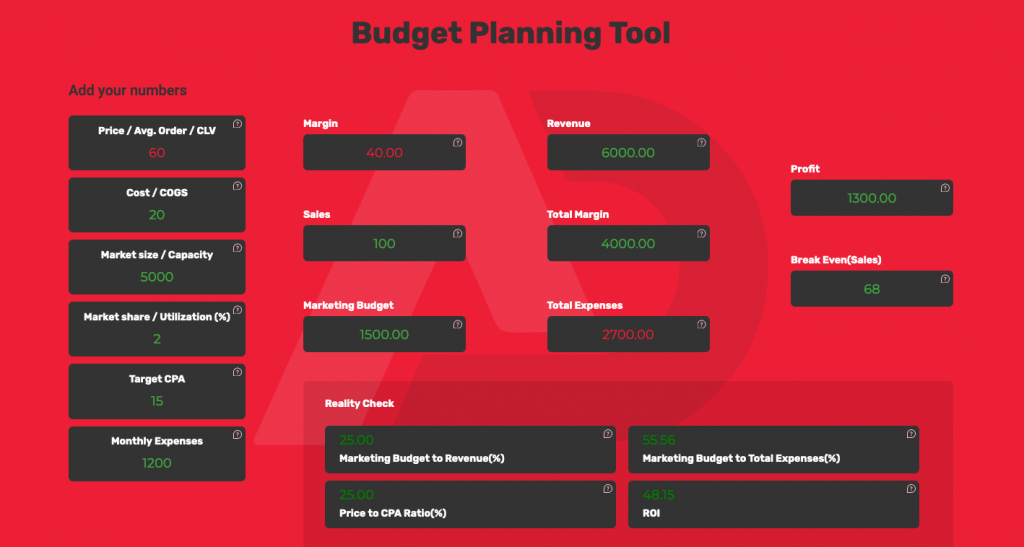
The Formula For Success Lies In The Numbers
You’ve already had an idea of what products you are going to sell. You have made the initial product viability check, and today I will share with you the basic business budget formula that will help you figure out.:
- What profits will you make with the products you’ve chosen to sell
- How many sales you will have to make each month to reach the Break Even Point, and
- What marketing budget you can afford to bring clients to your ecommerce and make those sales.
You will be surprised how many businesses operate without having those numbers in front of them.
This is number ONE reason why 80% of ecommerce businesses fail despite the massive opportunity on the internet.
Drafting a budget is crucial in helping you turn your dreams for business success into reality. Using this vital tool will help you anticipate future needs, spending, profits, and cash flow. It also may let you spot problems early on so that you can switch gears.
Profitability isn’t guru magic, it’s math.
Don’t worry if math is not your strength. We’ve got you covered. To simplify the necessary calculations, we have created a practical, easy, and 100% free to use Business Budget Planning Tool that will help you calculate your profits.
Whether you are a newbie to business or an experienced entrepreneur, this tool will make your life easier. Not only will you know if and what it will take to make your business profitable, but you will need this to make corrections and apply different growth strategies (more for them later).
Let’s take a look at the Basic Business Budget Formula:
There are six controllers you will have to fill out to get your numbers: Price, Cost/COGS, Market Size, Market Share, Target CPA, and monthly expenses.
Once you plug in all your figures, the calculator will do the hard work for you.
Let me explain how it works:

Price / Av. Order / CLV
Price is the amount of money your customers pay. The price you will sell the product.
If you already have a business, instead of the price you can fill in your Average Order or Customer Lifetime Value (CLV).
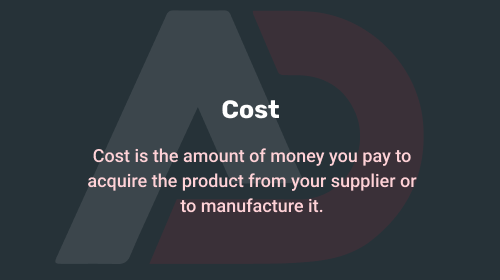
Cost
Cost is the amount of money you pay to acquire the product from your supplier or to manufacture the product.
To be more precise, it’s better if you calculate your Cost of Goods Sold (COGD). COGD includes:
Cost of Product + Shipping from the supplier to you + Credit Card Fees = Cost
Cost of Goods Sold sums to all expenses associated with making or buying your product PLUS the shipping from the supplier to you (your home, warehouse, or a fulfilling center like Amazon) Plus the fees that you will pay to your card processor when a customer orders from your ecommerce website. That’s usually around 2.9% plus $0.30 – it depends on your credit card processor. You can check that out on the website of your payment gateway.

Margin
Margin is the difference between your merchandise cost and the selling price.
Price – Cost = Margin
For example, if you buy a product for $6 and then sell it at $30 you have a $24 margin.
Note: When choosing your target price, make sure that you have at least a 40% Margin. Otherwise, you might not be profitable enough to sustain your business.
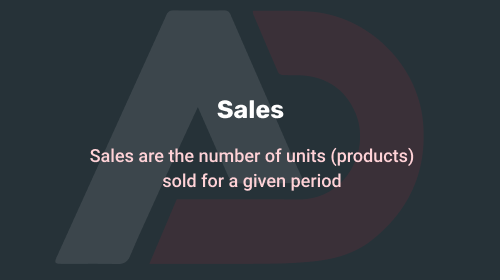
Sales
The next thing you need to figure out is your Target Sales. Sales are the number of units (products) sold.
Important! This is not to be confused with Orders which can have multiple units sold in them. For example, your customers can buy 2 products with a single order. In this case, we can consider that we have made two sales.
Or, you can add Average Order instead of Price of a single product, and this will count for a single sale. For example, if the average customer order is $20 (two products at $7 and $13), you might add $20 instead of the price of one of the products in the Price controller.
You can estimate your Target Sales by:
Market Size x Market Share = Sales
Sales are a budget’s “cornerstone.” Try to make these estimates as accurate as possible, but err on the side of being conservative if you have to.
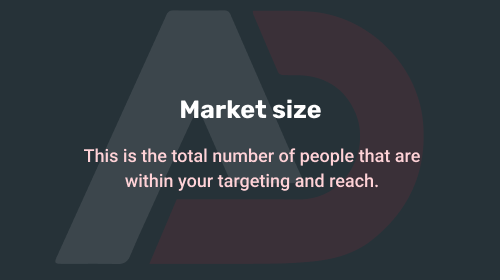
Market Size
This is the total number of people that are within your targeting and reach. To calculate the market size you can use existing marketing research and marketing platforms information depending on targeting.
Let me give you an example: if you sell bracelets, you may want to reach men between 30-45 age, who are married and will have an anniversary in the next two months. This is your target audience. You can then go to Facebook ad manager and see how many men there are within your target. And this is your Market Size. Let’s say, 5,000 people.
Note: You can’t target all men and women because you do not have a big enough marketing budget to reach them. You need to think about what people would be most willing to buy your product and they will be your initial target market.

Market Share
The percentage of the market size that is your customers.
For example, if the market size is 5,000 people and you sell to 50 of them you have 1% market share.
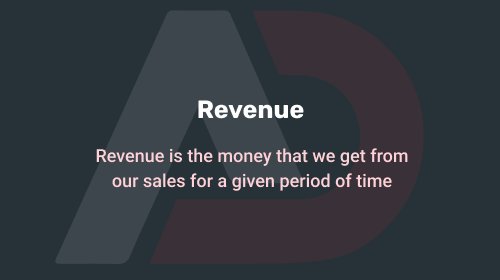
Revenue
Revenue is the money that we get from our sales for a given period of time
Note! Do not confuse this for profit. You can have millions in revenue and still operate at a loss.
The revenue is equal to the product sale price multiplied by the number of sales.
Price x Sales = Revenue
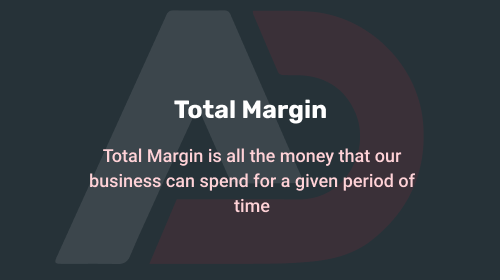
Total Margin
Total Margin is all the money that our business can spend for a given period of time
The Total Margin is the amount of money we will have after covering all costs related to purchasing and delivering the products to the customers.
Margin x Sales = Total Margin
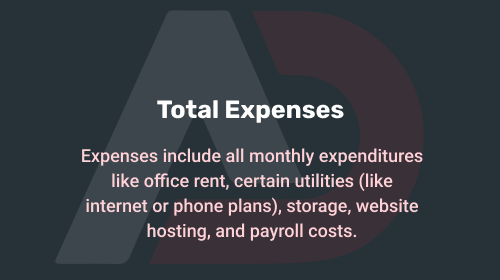
Total Expenses
Expenses include all monthly expenditures like office rent, certain utilities (like internet or phone plans), storage, website hosting, and payroll costs.
Related article: Identify And Plan Your Ecommerce Expenses
Now that you have your sales estimates done, you can develop figures for how much it will cost your business to earn those revenues. Some of your monthly expenses remain the same from month to month, while others are dependent on the number of sales.
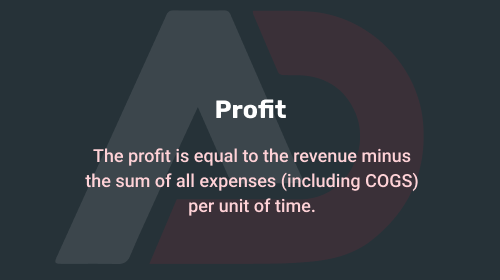
Profit
Let’s face it: you’re in business to make a profit. The profit is equal to the total margin minus the sum of all expenses per unit of time.
Total Margin – Expenses = Profit
For example, if this month you have $1000 revenue and your expenses (including COGS) are $650 you have $350 profit this month.
If your profit projections aren’t up to snuff you can troubleshoot your projected costs and see where you can cut.
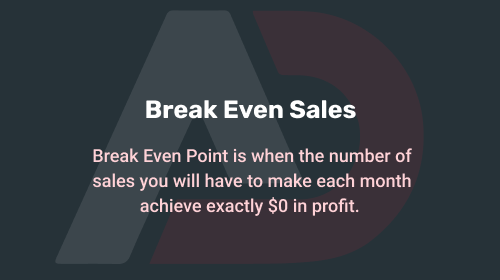
Break Even Point / Break Even Sales
Break Even Point is when the number of sales you will have to make each month get out of the red and achieve exactly $0 in profit. When you’ve broken even, you’re not making profit nor loss. All your costs have been covered.
Expenses / Margin = Break even point
If you need to make lots of sales before you can break even, then you have to ask yourself if your business plan is realistic – should you raise the price? Find a way to scale down cost? Or choose more profitable products?
Regardless of if your number of sales required to break even is five or 500, you’ll need a solid market strategy to get a profitable sales volume. Having a beautiful online store only wouldn’t do it.
So how to make this very important calculation.

Monthly Marketing Budget
In order to start advertising, you should know exactly how much money you can afford to spend on ads to make your target sales. Because if you spend too much money on ads to achieve your target sales, you will be at a loss at the end of the month. Here is your marketing budget formula:
Target CPA x Target Sales = Marketing Budget
For example, if you think you can sell pajamas on AdWords spending $2. This is your Target CPA. And if you want to sell 50 pajamas your marketing budget should be $100. Note that these $100 are a part of your Total Expenses.

Target CPA – Cost per Acquisition
The Target CPA is equal to the average amount of money you spend to acquire a new customer or sale. In other words, the price of obtaining a client.
For example, if this month you have 10 Sales and you spent $200 to get them your CPA is $20.
How to set your Target CPA? The truth is that you will be able to find the answer to this question only after you start advertising and gain some insights in your niche and target audience. However, a good rule of thumb is to spend between 50% to 70% of your Margin for Target CPA.
For example, if your Margin is $16 per product, then you can set a Target CPA of $8.
Sometimes we sell more products with a single order and then we look at the average price of the order. Sometimes we even look at the whole value of the client (Customer Lifetime Value).
If you have a customer retention strategy, your regular customers can buy let’s say 3 times a year from you. In this case with the same CPA of $20 instead of having 1 sale of $30, you will actually get 3 sales that sum up to $90. This is how we can improve the business math of our business.
This is why we are using this budget planning tool: to make a projection of what would happen if we reach a particular number of sales, particular market share, etc. We make our projections and set the business goals.
Now it’s your turn to play around and look at more “what if” scenarios. After viewing your first profits, go back, reset values, and put in different figures — like what if you pay less for the product, what if you make more sales by increasing your market share or start targeting new markets (market size), what if you acquire your sales with a bigger marketing budget, etc.
Use our instant budget tool to look at as many “what if” scenarios as you want. Then you can plug these figures into your business plan.
Once you launch your ecommerce, you can use your real figures to adjust your plans or expectations going forward. A 12-month budget can be updated with actual expenditures and revenues each month so that you know you’re on target. If you’re missing the targets set out in your budget, you can use the budget to troubleshoot by figuring out how you can reduce expenses like labor or new computers, increase sales by more aggressive marketing, or lowering your profit expectations.
Don’t worry too much because the basic tenet of budgeting is that the projected figures will never turn out to be exactly right.
What you need to do though, is to analyze your numbers, align your plan for the next month with what you’ve discovered, and execute again. That’s an infinite circle that helps you get better and better and slowly improve profits and scale your business.
The Formula For Success Lies In The Numbers
Always keep a pulse on the numbers to ensure your business stays out of debt and your investment in ecommerce is a profitable one.
One last thing, here is the formula for estimating your Return on Investment

Return on Investment
ROI is equal to the profit divided by the investment.
For example, suppose Joe invested $1,000 in Google shares. in 2010 and sold his shares for a total of $1,200. To calculate the return on his investment, he would divide his profits ($1,200 – $1,000 = $200) by the investment cost ($1,000), for a ROI of $200/$1,000, or 20%.
If you find your ecommerce planning difficult, Elena and I are always ready to land a helping hand. Just get in touch at info@airdesigns.us or join our Facebook group

